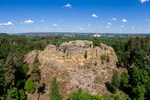Despite the destruction during World War II, half-timbered buildings can be found in the centre.
All the most important sights are located around the Cathedral Square (Domplatz), all the photos in this article were taken while walking around the square, so you can get around pretty quickly.
The square is bounded on one side by the Cathedral of St Stephen and St Sixtus (Dom zu Halberstadt), a cross-shaped basilica built in the 13th-15th centuries in the North French Gothic style, which today serves as a Protestant church.
And on the other is the Church of the Virgin Mary (Liebfrauenkirche), one of the few surviving four-towered Romanesque basilicas in central and northern Germany. Its 1000th anniversary was celebrated in 2005.
Another religious building, is the St. Martin's Church (St. Martini) in the Gothic architectural style. It was originally built in the late 13th to the first half of the 14th century, but was destroyed during World War II and rebuilt later. The tower has an observation deck, though at the time of our visit, all entrances were closed.
Like the cathedral, the design of the former residence of the abbot of the cathedral (Dompropstei) is also atypical of Germany, looking more like Italy. The building was constructed between 1591 and 1611.
City museum.
The wall behind the museum
Houses on the cathedral square.
Memorial to the Jewish victims near the cathedral.
Cathedral Square is elevated, this is clearly visible from the car park.
Getting there: parking 51.896556, 11.045917. Halberstadt Hbf train station is 2 km from Cathedral Square.


























